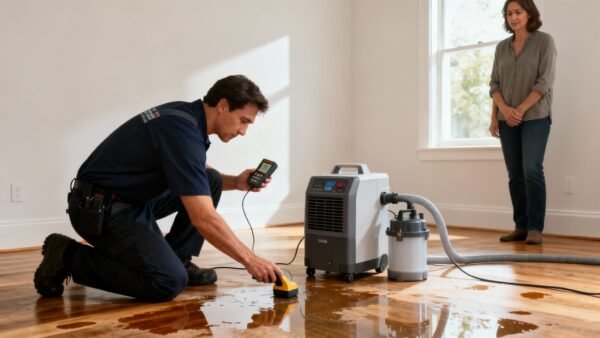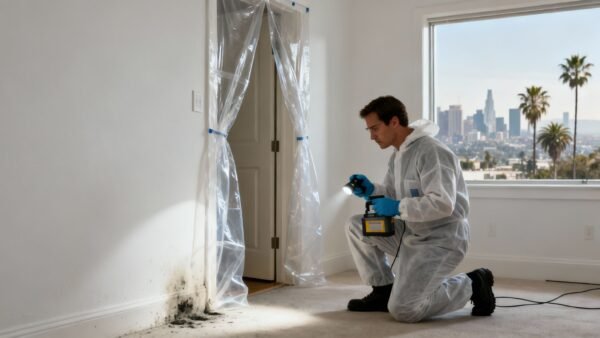That moment your heart sinks—when you discover a leak from a flat-roof in Sherman Oaks or a full-blown flood in your basement—is pure panic. But what you do in the next few minutes is absolutely critical. Your first priority isn’t cleanup; it’s safety. For Los Angeles homeowners, the first steps are to shut off the main water valve and the circuit breakers for any wet areas. Getting this right can dramatically slash the long-term damage and costs of any water damage restoration service you hire.
The Hidden Dangers of Indoor Water Damage
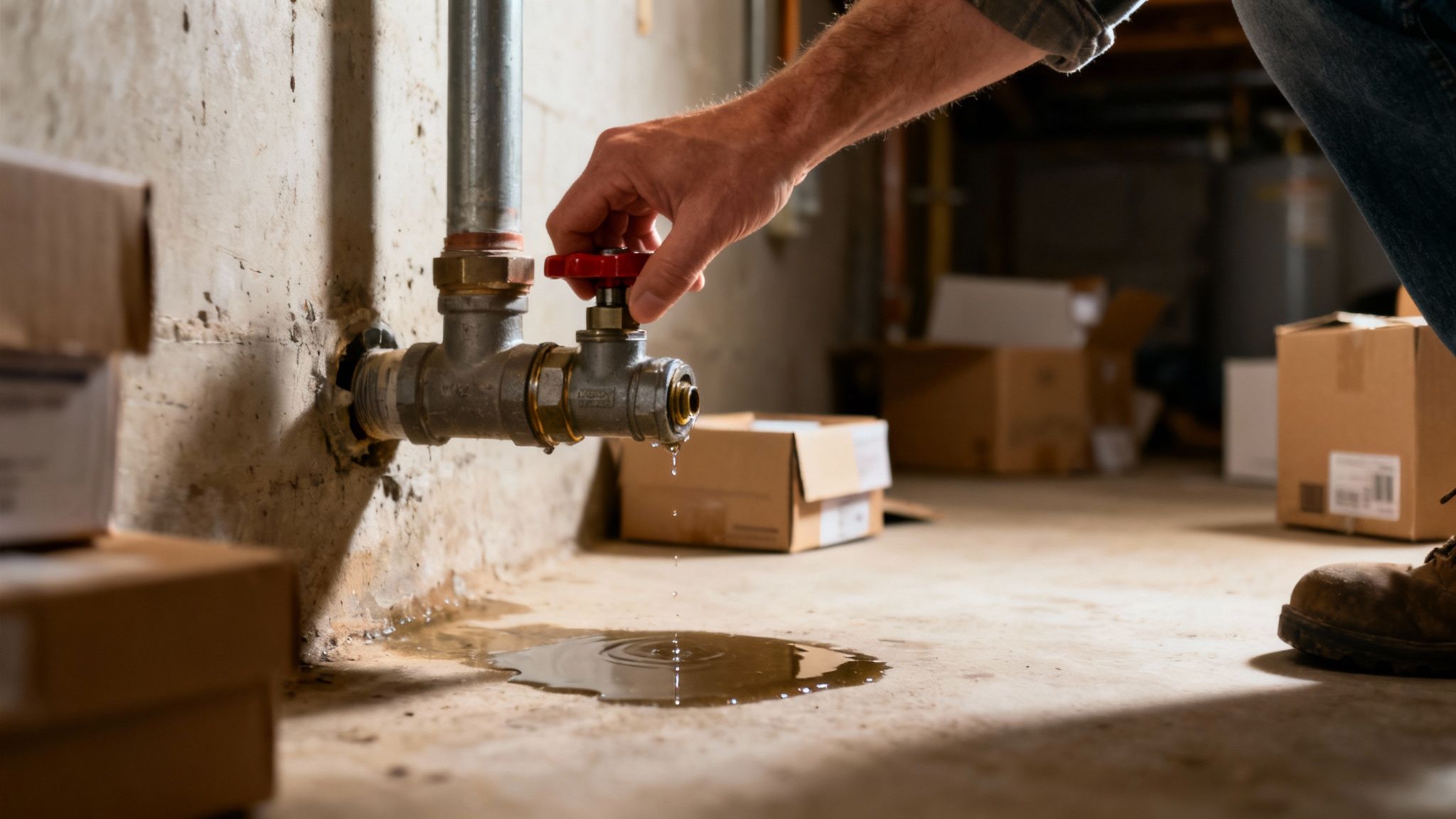
Whether it’s a burst pipe flooding a Van Nuys kitchen or a water heater letting go in a Studio City basement, the first few moments feel chaotic. The key is to remember your goal isn’t to fix the problem yourself. It’s to contain the mess and keep it from getting worse while you call in a professional water damage restoration service near you.
This initial response is all about mitigation—stopping the source of the water and protecting your property from more harm before the experts arrive.
Prioritize Safety Above All Else
Before you even grab a towel, you need to make the area safe. Water and electricity are a deadly mix, especially in older Los Angeles homes.
- Kill the Power: Head straight for your home’s breaker box and flip the breakers for the rooms that are wet. If you have to stand in water to get to the box, stop. Don’t risk it. Call an electrician or the restoration company first.
- Stop the Water Source: Find your home’s main water shut-off valve. In most homes, it’s in the basement, a crawl space, or near the water heater. Turn it clockwise all the way to close it off. This stops any more water from coming in.
- Check Gas Appliances: If the leak is near a gas appliance like a furnace or water heater, shut off its dedicated gas valve, too. This is a crucial step to prevent a potential gas leak.
Document Everything for Your Insurance Claim
Once you’ve handled the immediate safety risks, switch gears and become a detective for your insurance company. They won’t just take your word for it; they need detailed proof to process your claim correctly.
Key Takeaway: Solid documentation is your best friend when filing an insurance claim. Without good evidence, you risk having your claim denied or underpaid, forcing you to cover major expenses out of pocket.
Grab your smartphone and start taking photos and videos. Get wide shots of the entire scene, then zoom in for close-ups of everything that’s damaged—soggy drywall, soaked furniture, standing water. It helps to narrate your videos, explaining what you’re seeing and when you found it. This builds a clear timeline for the insurance adjuster. Knowing the common signs of water damage will also help you spot and document issues that might not be immediately obvious.
Protect Your Belongings
With documentation out of the way, it’s time to start moving what you can. The goal here is simple: get valuables and items that absorb water to a high and dry spot.
- Move electronics, furniture, rugs, and important papers to an unaffected room.
- For heavy furniture you can’t move, slip small pieces of aluminum foil or wood blocks under the legs. This stops wood stains from bleeding into wet carpet.
- Lift curtains, drapes, and furniture skirts off the wet floor so they don’t wick up moisture and become ruined.
These quick actions won’t solve the core problem, but they create a safer work area and prevent a lot of secondary damage. You’re setting the stage for the professionals to come in and do their work effectively.
How to Choose the Right Water Damage Restoration Service Near Me
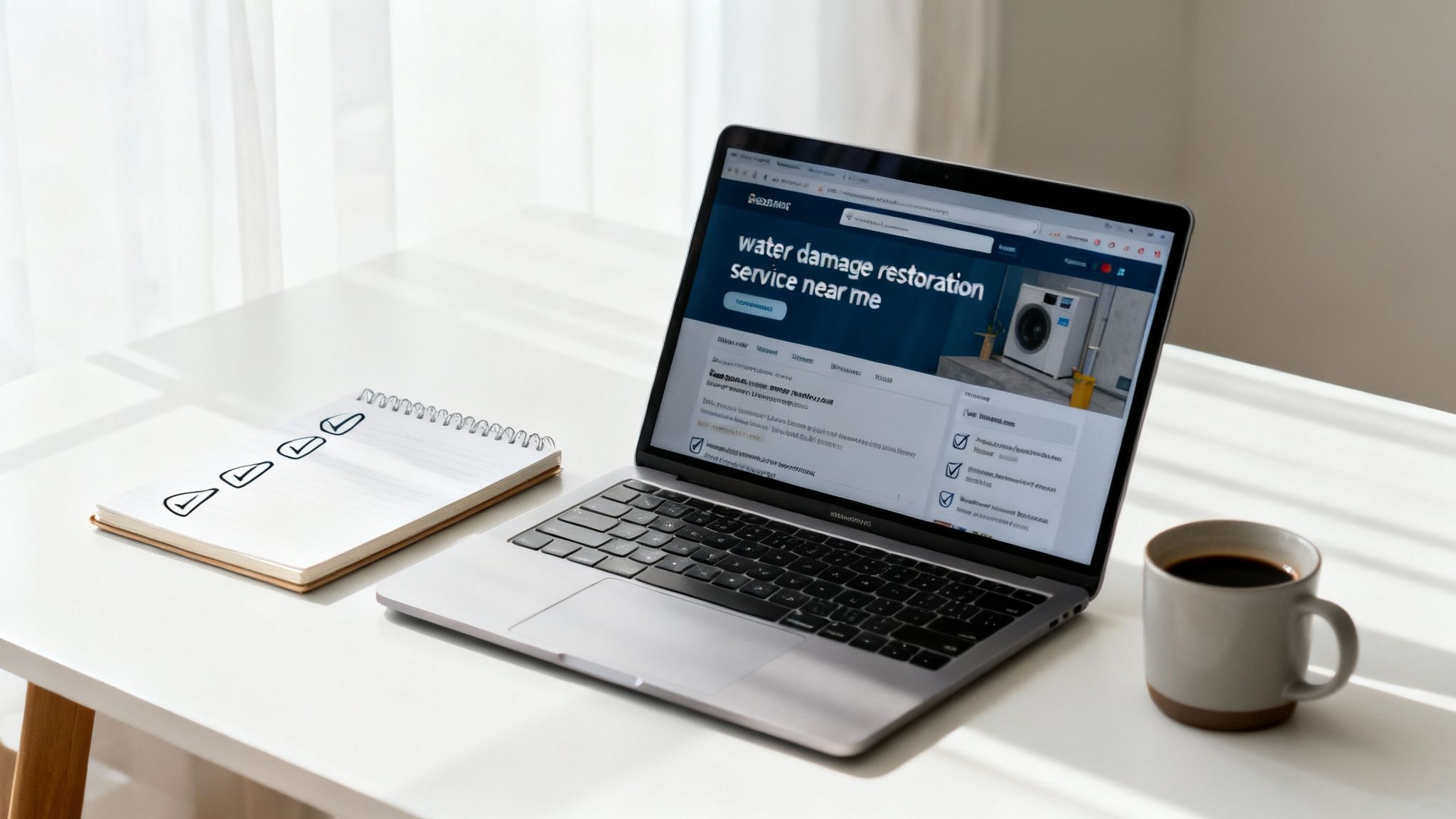
When you’re frantically Googling “water damage restoration service near me,” the goal is simple: find a trustworthy team, and find them now. You don’t have days to vet companies while water seeps deeper into your walls and floors. A strategic search is your best friend here, helping you build a solid shortlist of pros in under an hour.
The restoration industry is bigger than ever, with over 35,000 companies across the U.S. That number is only growing, with industry revenue projected to hit $7.1 billion by 2025, largely thanks to an increase in severe weather events. More options are good, but it also means you have to cut through more noise to find the real professionals. You can read the full report on damage restoration services here for more on these trends.
Start With Trusted Sources
Instead of just casting a wide net online, start with sources that have already done some of the vetting for you. This immediately adds a layer of credibility.
- Your Insurance Provider: Your first call should be to your insurance agent. They keep a list of preferred restoration vendors they already trust to do quality work and, just as importantly, provide the right documentation for a smooth claim.
- The IICRC Directory: The Institute of Inspection, Cleaning and Restoration Certification (IICRC) is the gold standard for training in this field. Use their official locator to find certified firms right in your neighborhood. Honestly, IICRC certification is a non-negotiable credential.
Pro Tip: A company on your insurer’s list or in the IICRC directory isn’t just a suggestion. It’s a strong signal that they meet professional standards for training, insurance, and ethical conduct. It’s a huge shortcut to quality.
Look Beyond the Star Rating
Online reviews are a goldmine of information, but you have to read between the lines. A simple five-star rating doesn’t tell you what it’s really like to work with a company during a crisis.
Scan the most recent reviews for specific phrases that tell the story. I always look for comments that mention things like:
- “Fast response” or “arrived quickly”
- “Clear communication”
- “Professional crew”
- “Helped with insurance”
These are the keywords that prove a company excels where it counts most in an emergency. On the flip side, any mention of poor communication, surprise charges, or a messy worksite is an immediate red flag.
This approach helps you understand not just if they did a good job, but how they handle the stress and logistics of a real-world water emergency. Our guide on choosing a flood damage service dives even deeper into what to look for in reviews.
By combining these tactics—starting with certified sources and then digging into the details of real customer experiences—you can confidently build a shortlist of reputable companies. This focused approach saves you precious time and gets you on the phone with teams that are truly equipped to handle the job right from the start. Your next step? Vetting those finalists with a few pointed questions.
Vetting Your Shortlist of Restoration Companies
Alright, you’ve got a short list of potential companies. Now for the most important part: the deep dive. This is where you separate the real pros from the fly-by-night outfits.
Asking the right questions before anyone sets foot in your home is the single best way to protect yourself. It helps you dodge scams and guarantees the team you hire to handle your water damage restoration service near me is actually qualified for the job.
A true professional will have no problem with your questions. In fact, they’ll welcome them. If you get vague answers, pushy sales tactics, or a flat-out refusal to show credentials, that’s a massive red flag. Thank them for their time and move on.
First Things First: Verify Their Credentials and Insurance
Before you even start talking about the specifics of your water damage, you absolutely must confirm the company is legitimate and insured. This step is non-negotiable.
- Ask for their IICRC Certification: The Institute of Inspection, Cleaning and Restoration Certification (IICRC) is the gold standard in this industry. A serious company will be certified. Ask for their certification number—if you want to be extra careful, you can even verify it on the IICRC website.
- Request Proof of Insurance: Any reputable company will carry both general liability insurance and workers’ compensation. Ask them to email you a copy of their certificate of insurance. This protects you if a worker gets hurt on your property or if their work somehow causes even more damage.
This initial check is your fastest way to weed out the “storm chasers” and unqualified operators who often pop up after a major weather event, preying on homeowners in a crisis.
This simple infographic breaks down the core steps for vetting a water damage restoration company.
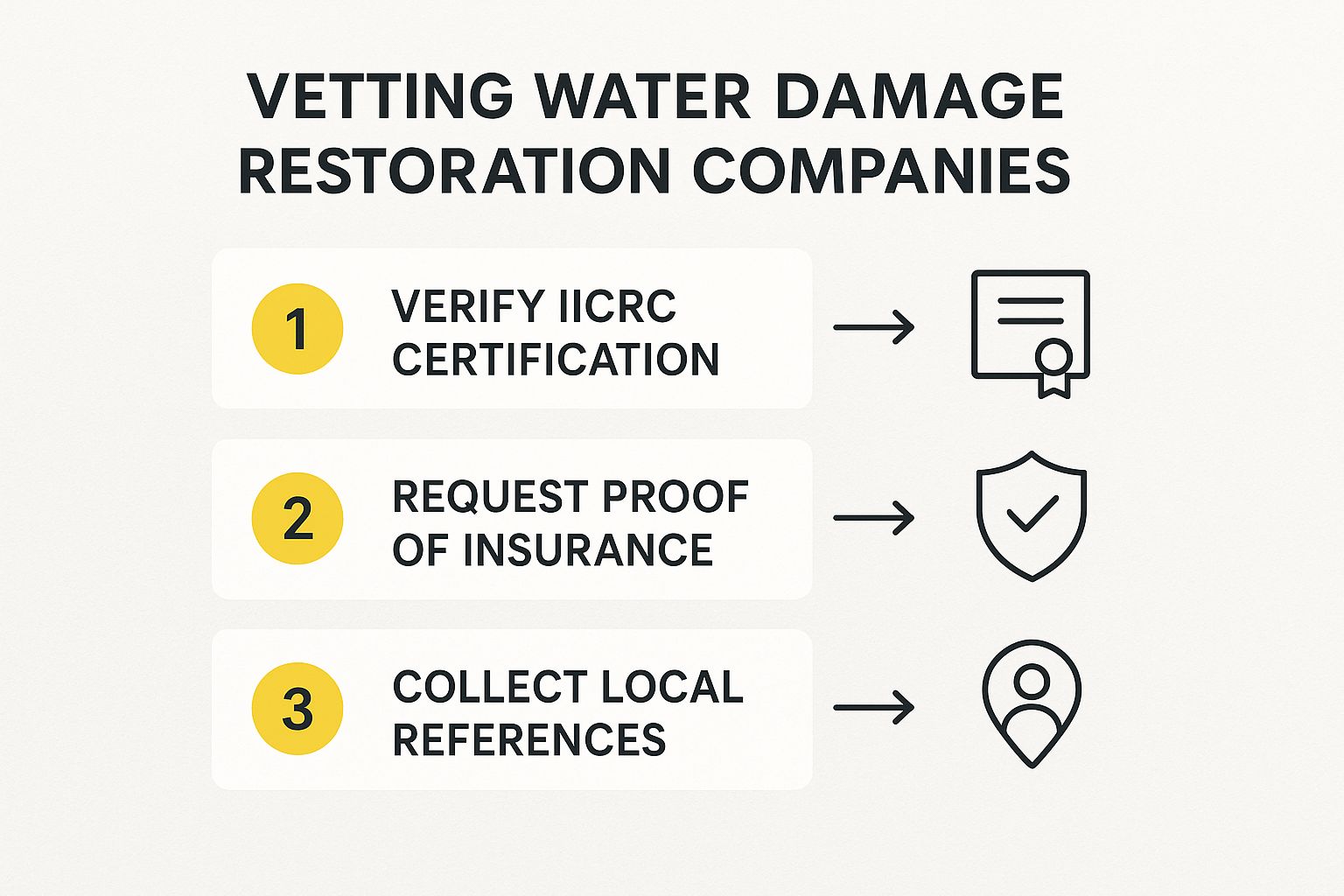
Following a logical process like this ensures you cover all your bases—from certification and insurance to their real-world track record—before you sign anything.
Get Into the Weeds: Ask About Their Process and Equipment
Next, you need to find out how they actually plan to fix your specific problem. The way they answer tells you everything about their expertise and whether they follow proper industry procedures.
Ask them to walk you through their typical process. A pro should immediately talk about an initial assessment using moisture meters, followed by water extraction, setting up drying equipment like air movers and dehumidifiers, and performing daily moisture monitoring. If they can’t explain this clearly, it’s a sign they might not have the right training.
Also, ask what kind of equipment they use. Do they own industrial-grade dehumidifiers and high-velocity air movers? Do they use moisture detection tools like thermal imaging cameras to find hidden water pockets? Using the right gear is what separates a quick fix from a permanent solution, especially when it comes to preventing mold down the line.
Key Insight: The difference between a successful restoration and a future mold problem often comes down to the thoroughness of the drying process. A company that relies on guesswork instead of moisture-reading technology is taking a major risk with your property.
Check Their Track Record: Local Experience and References
A company’s history in your specific area speaks volumes. Ask how long they’ve been serving the Los Angeles community and if they can provide a few references from recent, local jobs. While online reviews are a good starting point, nothing beats talking to a past client for unfiltered feedback on their professionalism and the quality of their work.
Seeing what others have said in our company reviews can give you a clear picture of the client experience you can expect.
To make this process easier, I’ve put together a checklist of questions to ask every company you’re considering. This helps you compare apples to apples and make a confident decision.
Key Questions for Potential Restoration Companies
Use this checklist to vet each company’s credentials, experience, and processes before making a hiring decision.
| Question Category | Specific Question to Ask | Why This Matters |
|---|---|---|
| Credentials & Insurance | “Are you IICRC-certified, and can I see your proof of liability and workers’ compensation insurance?” | Confirms they are professionally trained, legitimate, and that you are protected from liability. |
| Experience | “How many years have you been in business in this area? Can you provide local references?” | Shows they have a stable, long-term presence and a proven track record with homeowners near you. |
| Process | “Can you walk me through your entire process, from assessment and extraction to drying and monitoring?” | Reveals their technical expertise and adherence to industry standards for safe and effective restoration. |
| Equipment | “What kind of drying and moisture detection equipment do you use?” | Ensures they have professional-grade tools (not just fans) to find and eliminate all hidden moisture. |
| Documentation | “How do you document the damage and the drying process for insurance claims?” | Proper documentation with photos and moisture readings is critical for getting your insurance claim approved. |
| Timeline & Communication | “What is the estimated timeline, and who will be my main point of contact?” | Sets clear expectations for the project duration and ensures you know who to call with questions. |
Asking these questions upfront will save you a world of headaches later. Finally, as you have these conversations, keep an eye out for these common red flags:
- High-Pressure Sales Tactics: Anyone demanding you sign a contract on the spot or asking for a huge upfront payment is a major red flag.
- Vague or “Too Good to be True” Quotes: A professional estimate is detailed. It breaks down costs for labor, equipment, and materials. If it’s just a single number on a piece of paper, be wary.
- No Physical Address: A real local business has a physical office or workshop in your area—not just a P.O. box or an untraceable phone number.
Taking a little extra time to properly vet your options ensures you hire a capable, ethical, and reliable team, turning a deeply stressful situation into a manageable one.
Understanding the Professional Water Damage Restoration Process
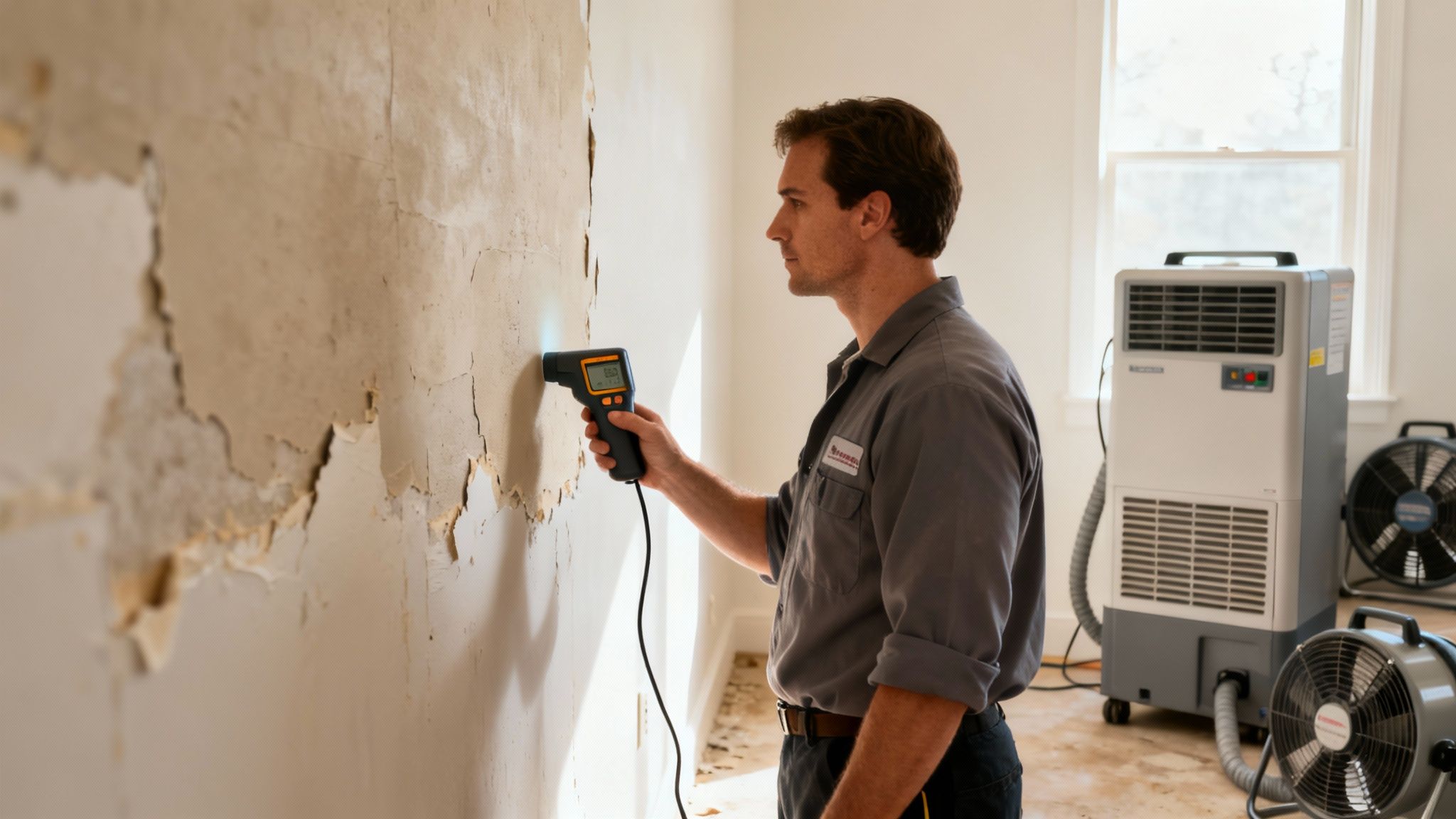
Knowing what a pro team will actually do when they show up can turn a moment of panic into a manageable project. It’s not just about sucking up water with a shop vac. Legitimate restoration pros follow a methodical, scientific process designed to get your home back to normal safely and completely.
This isn’t just about cleaning up a mess; it’s about preventing long-term structural rot and dangerous mold growth down the road, a common issue in coastal areas like Santa Monica due to fog and humidity.
More and more homeowners are realizing the risks of cutting corners, which is why the industry is growing so fast. The global damage restoration market hit around USD 13.8 billion in 2024 and is on track to reach USD 22.6 billion in just a few years. That surge is happening because people are demanding real expertise. You can read more about the damage restoration service market trends to see just how much the industry is evolving.
The First Steps: Assessment and Water Extraction
The moment the team walks in, their first job is a full-scale inspection. This is where you’ll see them pull out tools like moisture meters and thermal imaging cameras. They’re looking for the full scope of the problem, especially the hidden water that has wicked up behind walls or soaked into subfloors. This data is what they use to build a real plan of attack.
Once they know what they’re dealing with, the extraction starts immediately. You’ll see them bring in powerful, truck-mounted pumps and vacuums to get all the standing water out. This is the first critical move toward stabilizing your property and stopping the damage from spreading.
The Science of Drying: Air Movers and Dehumidifiers
Getting the visible water out is just the beginning. Materials like drywall, wood, and insulation are like sponges—they hold onto a surprising amount of moisture, creating a perfect environment for mold. This is where the real science of drying comes into play.
A professional team will set up a whole system of industrial-grade equipment to create the perfect drying conditions. This usually involves:
- High-Velocity Air Movers: These aren’t your average box fans. They’re strategically placed to push air across wet surfaces, which dramatically speeds up evaporation.
- Commercial Dehumidifiers: As moisture evaporates into the air, these powerful machines pull it right out. This prevents that damp, humid air from causing secondary damage, like making your wood floors warp or your paint peel.
A good crew won’t just “set it and forget it.” They’ll be back daily to take moisture readings, repositioning equipment until every affected material is back to its normal, pre-damage dry standard. This is the only way to be sure no hidden moisture is left behind.
Cleaning Up and Rebuilding
Once everything is verifiably dry, the final stage begins. This is all about cleaning, sanitizing, and putting things back together. The team will treat affected areas with antimicrobial agents to kill off any lingering bacteria and stop mold from getting a foothold.
Any materials that couldn’t be saved—think warped flooring or drywall that has started to crumble—are carefully removed and replaced. The ultimate goal is to return your home to the way it was before the disaster, making it a safe and healthy space again.
If you’re curious about the nitty-gritty details, our guide on structural drying for homeowners breaks down this critical process even further.
Navigating Your Water Damage Insurance Claim in California
Let’s be honest: dealing with your insurance company can feel even more stressful than the water damage itself. One minute you’re scrambling to stop a leak, the next you’re drowning in paperwork and confusing policy terms. But you can get through this. A calm, methodical approach is your best bet for managing the claim and getting the payout you need.
Once you’ve made sure everyone is safe, your very first call should be to your insurance agent. Give them a clear, simple rundown of what happened. This phone call is what officially kicks off the claims process and gets an insurance adjuster assigned to your case.
Documentation Is Your Strongest Ally
From this moment forward, think of yourself as a detective. Meticulous documentation is everything. Your adjuster needs solid proof to sign off on every part of your claim, and this is where a top-notch water damage restoration service near me becomes an indispensable partner.
A professional team won’t just start tearing things out. They’ll build your case for you by providing comprehensive records, including things like:
- Tons of photos and videos showing the damage exactly as they found it.
- Moisture maps and daily readings that track the drying process.
- A complete, itemized list of every damaged material they had to remove.
This isn’t just busywork. This evidence proves the true extent of the damage and justifies every single step they take, leaving very little room for your insurance company to argue.
Understanding Your Policy and Your Restoration Partner
It’s important to know that most standard homeowner’s policies are designed to cover “sudden and accidental” water damage—think a burst washing machine hose or a ruptured pipe. They almost never cover damage from slow, gradual leaks, as that’s considered a maintenance issue. Our guide on homeowners insurance coverage for water damage dives much deeper into these crucial differences.
Key Takeaway: A professional restoration company does way more than just dry your house. They’re your expert liaison with the insurance company. They speak the same language as adjusters and provide the exact, detailed documentation needed to get your claim approved without headaches.
This partnership is invaluable. The property restoration industry is growing fast, especially with the increase in major weather events. Between 2019 and 2023, the U.S. was hit with over 100 separate billion-dollar disasters. Because of this, about 20% of restoration companies now specialize in water damage, and 56% of them are forecasting revenue growth for 2025. You can discover more insights on the restoration industry outlook on purocleanfranchise.com. That level of expertise means they know exactly how to handle the insurance maze.
My advice? Keep a dedicated folder—physical or digital—for everything related to your claim. Every email, every receipt, every report. Log every phone call with the date, time, and the name of the person you spoke with. Staying organized like this keeps you in the driver’s seat and empowers you to advocate for the full and fair settlement you’re entitled to.
Unique FAQs About Water Damage Restoration in Los Angeles
When you’re staring at a flooded basement or a spreading ceiling stain, your mind starts racing. It’s a chaotic and stressful moment for any homeowner. Getting fast, clear answers is the first step toward taking control of the situation.
Here are the questions we get asked most often by clients who just searched for a “water damage restoration service near me,” along with the straightforward answers you need.
Q: How quickly should a restoration company arrive at my Los Angeles home?
A: In a true emergency, a reputable company should be at your door within 1 to 4 hours. With water damage, the clock is your biggest enemy. Mold can start growing in as little as 24-48 hours in damp conditions. A rapid response isn’t just a selling point; it’s the single most important factor in preventing further destruction and keeping your total repair costs from skyrocketing. Always prioritize companies that guarantee 24/7 availability and a fast arrival time.
Q: Can I just dry out water damage myself?
A: For a tiny spill on a waterproof surface like a tile floor, sure, towels and a fan might do the trick. But for anything more serious, going the DIY route is a huge gamble. Water is sneaky. It quickly seeps into porous materials you can’t see—drywall, wood subfloors, insulation, and carpet padding. Without the right equipment, there’s no way to tackle that hidden moisture. Professionals use tools like moisture meters and thermal imaging cameras to hunt down every last pocket of water.
Q: What’s the difference between water mitigation and restoration?
A: It’s easy to get these terms mixed up, but they represent two very different phases. Water Mitigation is the emergency “stop the bleeding” phase, focusing on extracting water, removing soaked materials, and stabilizing the environment. Water Restoration is the repair and rebuilding phase that begins once everything is confirmed to be bone-dry, including replacing drywall, installing new flooring, and returning your home to its original condition.
Q: Does my homeowners insurance cover all water damage?
A: This is a big one, and unfortunately, the answer is no. Standard homeowners insurance policies are designed to cover damage from “sudden and accidental” events, like a burst pipe. Gradual damage from slow leaks or a leaky shower pan is almost always excluded as a maintenance issue. Furthermore, overland flooding from storms is never covered by a standard policy; for that, you need a separate policy from the National Flood Insurance Program (NFIP).
Q: How do I know if the drying process is truly complete?
A: A professional restoration company doesn’t guess—they measure. They will use moisture meters to test affected materials like drywall and wood daily. The job is only considered complete when these materials have returned to their normal, pre-damage moisture content, known as the “dry standard.” This scientific approach is the only way to guarantee no hidden moisture is left behind to cause future mold or rot.
Q: Is it safe to stay in my home during the restoration process?
A: It depends on the extent of the damage and the type of water. For a small, clean water leak (Category 1), it may be possible to remain in unaffected areas of the home. However, if the damage is extensive or involves contaminated water (Category 2 “greywater” or Category 3 “blackwater” from sewage), it is often safer and more practical to relocate temporarily to protect your family’s health and allow the crew to work efficiently.
If you’re dealing with water damage right now, don’t wait. The Onsite Pro Restoration team is on call 24/7 to give you immediate help and walk you through every single step. Call us now for a free, no-obligation assessment.



